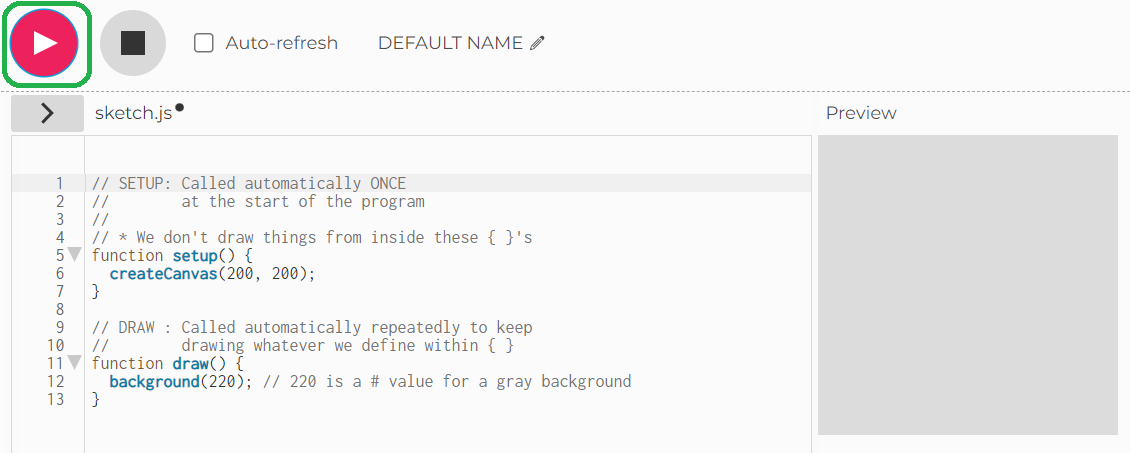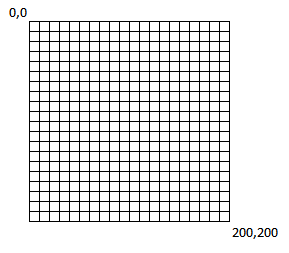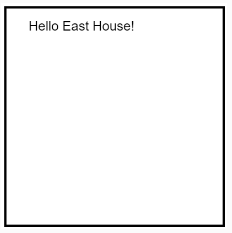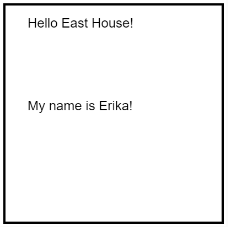EVERY software developer starts with a “Hello World” project!
Create a new sketch
Use File -> New to create a new default program.

The editor will give it some kind of silly default name (e.g., “Fossil accelerator”). You can change the name to whatever you want.
Copy/paste in this demo code
// SETUP: Called automatically ONCE
// at the start of the program
//
// * We don't draw things from inside these { }'s
function setup() {
createCanvas(200, 200);
}
// DRAW : Called automatically repeatedly to keep
// drawing whatever we define within { }
function draw() {
background(220); // 220 is a # value for a gray background
text("Hello East House!", 25, 25);
// New text and a y coordinate further down on the canvas
text("My name is Erika!", 25, 100);
}
Running the program
Press the play button to run the program. The default sketch will draw a single gray square.

What’s going on?
Program structure
Functions are sections of program code that the computer runs together. By default, every p5.js program has two main “functions”: setup and draw.
- Everything with the starting
{and ending}of the function will be run, in the order that it is written, by the computer when that function is called. - Any lines beginning with
//are ignored by the computer. These are comment lines and we use them to add our own notes to the program.
// SETUP: Called automatically ONCE
// at the start of the program
//
// * We don't draw things from inside these { }'s
function setup() {
createCanvas(200, 200);
}
// DRAW : Called automatically repeatedly to keep
// drawing whatever we define within { }
function draw() {
background(220); // 220 is a # value for a gray background
}
To make the program actually do something, we call command statements within the functions. The default program has two of these already:
createCanvasto specify the size of the drawingbackgroundto reset the background color every time the picture is drawn
Drawing
Everything we draw using p5.js is placed onto a canvas. In order to draw something onto the canvas, we need to know:
- what we want to draw
- where we want to draw it
What is typically a shape of some sort (text, circles, lines, etc.).
Where is a coordinate on the canvas. We define these coordinates as a pair of offsets from the top left corner of the canvas: (x,y).
- x: The number of pixels right from the left side of the canvas.
- y: The number of pixels down from the top side of the canvas.
For example, in the 200x200 canvas defined above, the top left would be at x=0, y=0. The bottom right would be at x=200, y=200. We can represent this using a coordinate grid.
We provide the coordinate where we want to start drawing to draw something at a specific location on the canvas.
To draw the text “Hello East House!” in the top left corner of the canvas (with a small offset right and down), we add a statement draw the text at the coordinates x=25, y=25.
function draw() {
background(220); // 220 is a # value for a gray background
text("Hello East House!", 25, 25);
}
The createCanvas, background, and text commands used above are examples of function calls. In other words, we are telling the computer to run other functions (like setup, but written by someone else) using information we provide.
In the case of text, we’re providing 3 pieces of information:
- The text to draw:
"Hello East House!" - The x offset:
25 - The y offset:
25
These three pieces of information are called parameters. The actual information passed in for each is called data.
The same command, called with different data for each parameter has different results.
// New text and a y coordinate further down on the canvas
text("My name is Erika!", 25, 100);


